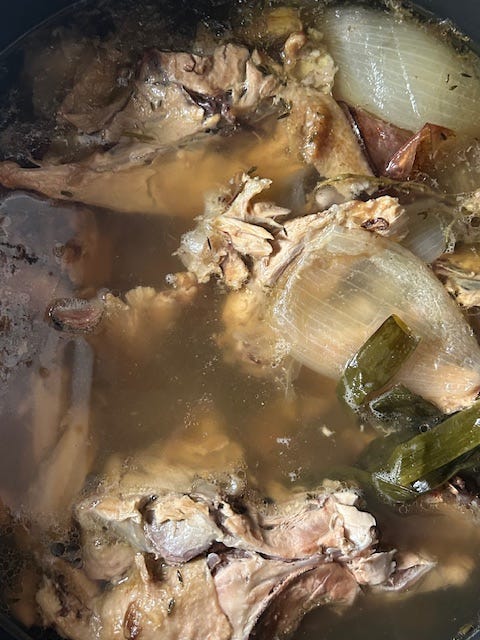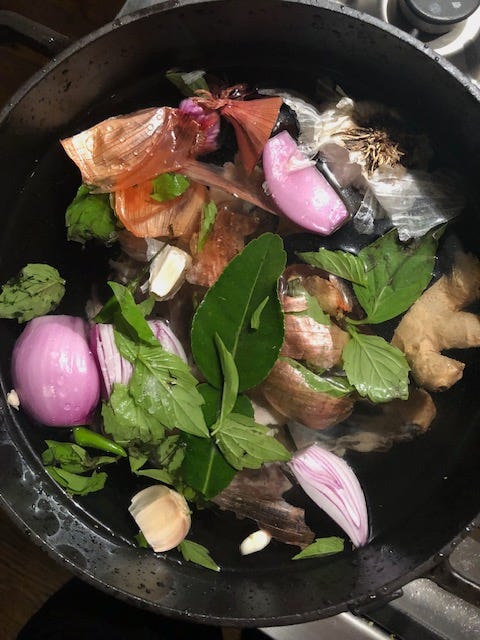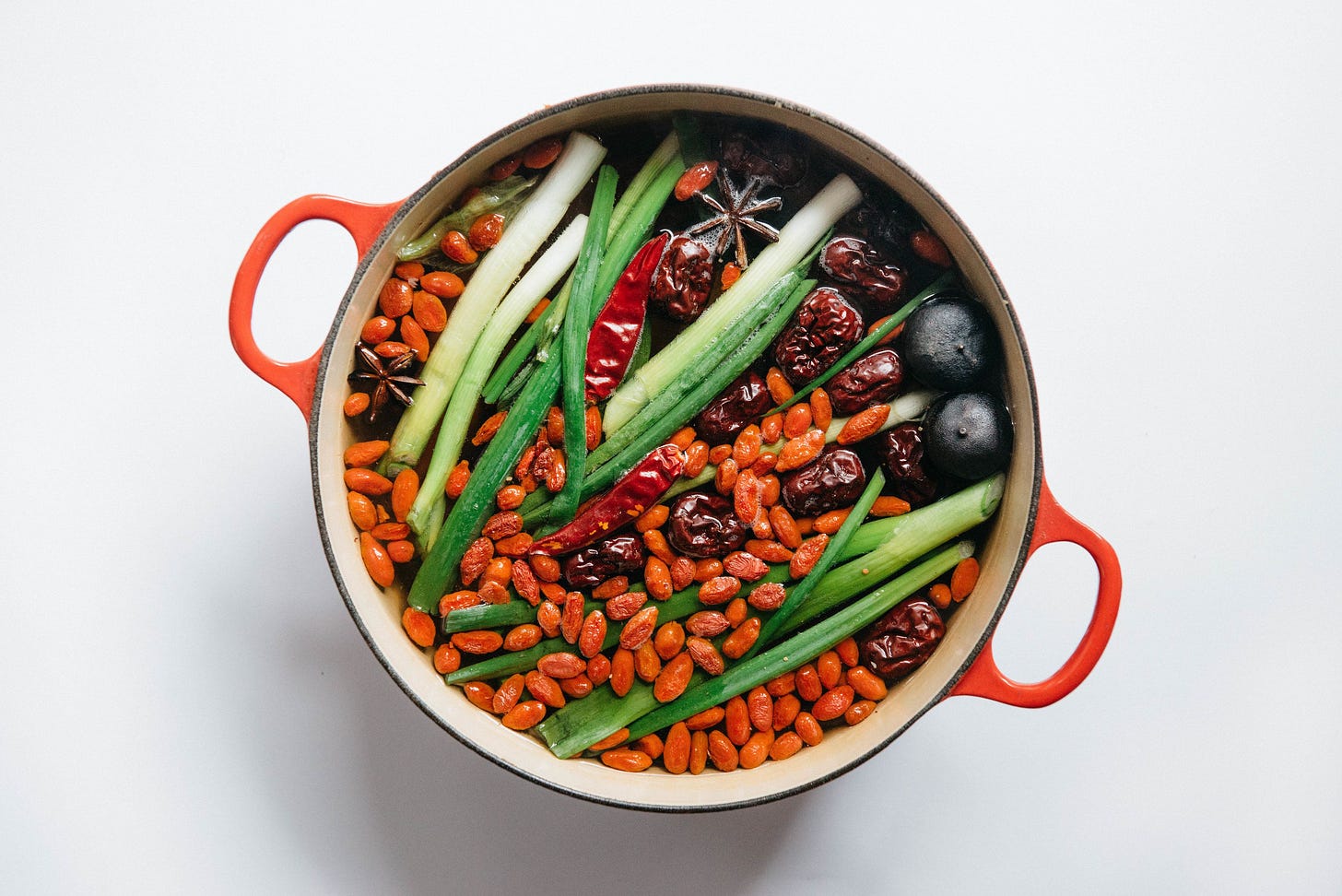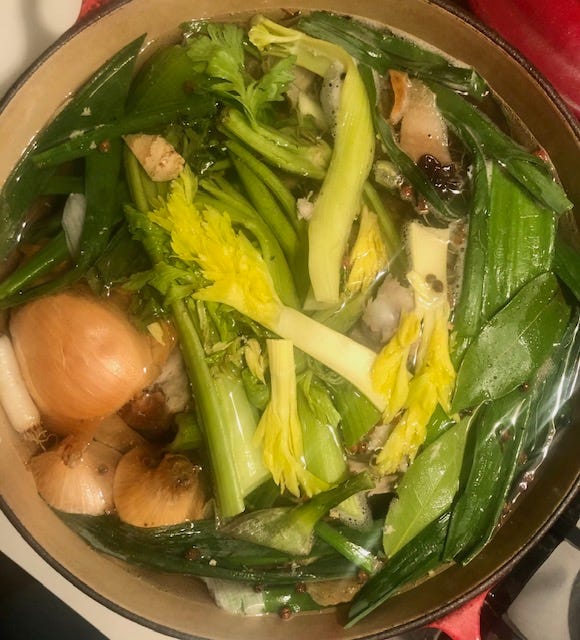
I am writing this post with a box of tissues beside me and a never-ending cup of steaming tea with honey, ginger and lemon at arm’s reach. I’ve had an unrelenting head cold for well over a week…the kind of cold that wanes, and just when you think you’ve turned a corner towards wellness, it takes you down for another deep sniffly, muscle achey turn. So I figured it was an appropriate time for a post about broth, because it really is true, chicken soup cures all. Perhaps that’s a slight overstatement, but any brothy warm liquid will help clear sinuses and nourish that cold right out you. Throwing some roasted chicken carcasses (and/or necks, wings, feet if you can get them) into a pot along with whatever vegetable/herb scraps that are lying around is one of the simplest, quickest ways to good nourishment. Side note—any independent butcher and most grocery store butchers will have carcasses, backs, necks etc to sell you, just ask if you don’t see them in the display case. I much prefer simmering my own stock and adjusting the flavor intensity and salt quotient than purchasing it pre-made from a high-end butcher or grocery store selling bone broth. There’s something very satisfying and life-affirming about making your own stock. And yes, it can take a number of hours, which perhaps you don’t always have…but, here’s a small secret, I’ll often start a stock a few hours before I go to bed and turn the stove off and let it sit overnight and finish it for another 1-2 hours in the morning. Or if you have an induction top that will shut off on its own after 3-4 hours as a safety measure, I’ve even gone to bed with it still gently simmering and it’s basically finished when you wake. Either way, food safety will not be compromised I swear…the beauty of broth is you can bring it back to a boil and blast any worry away. And of course if you’ve got an Insta-pot, crock pot or pressure cooker, all of those will get you a nice rice broth or stock even more quickly.
If you’re wondering what the difference between a stock and a broth is, (I always do), technically stock is liquid with roasted bones which provides for a richer flavor and collagen extraction from the bones (collagen is great for anti-aging/wrinkle prevention, boosting immunity, digestion and joint and gut health and reducing inflammation). The collagen in stocks cause it to gel when cooled. You know you’ve got a super rich stock when it’s a gelled brick coming out of the fridge. And if you continue to reduce down a stock at a very gentle simmer, it’s texture will thicken and deepen even further and then you get a “demi-glace” (a half reduction) that can serve as the base for sauces (all those traditional fancy French core sauces or really any other deeply flavorful sauce). A broth tends to be lighter in flavor and is technically cooked with meat. But then if you think about, the term “bone broth” is a bit contradictory.
To be honest, I make stock pretty frequently and use it for all purposes: for sipping in a cup when I’m feeling under the weather like right now, for fortifying a stew/braise/soup, for reducing a bit further for a pan sauce and probably other things I can’t currently think of because my head is so foggy and working at 70% capacity today. If you’re vegetarian or vegan, do not fear—you can get plenty of good nutrients from a vegetable stock, mushroom broth or miso+seaweed broth. And when I’m not surrounded by little piles of crumpled tissues, I loveee a parmesan rind broth for some really good umami that is a perfect partner for stewed beans and wintry dark leafy greens (also a great way to use the leftover rinds from any hard cheese, not necessarily parm). Alas, dairy and beans are not ideal for nurturing a head cold, so we’ll leave that for another day. And lastly, I’ve made a note in the second recipe below for making it vegan with seared mushrooms (yummm), but I’ll save a deep dive into vegan broths for another post.
Ok, onto 2 takes for a chicken stock/broth situation, one is a pretty classic / my go-to stock and the other is an aromatic variation that includes all the cold-busting ingredients that provide an extra boost of anti-inflammation and immunity.
Classic Chicken Stock
Makes 2-2 1/2 liters/quarts
2-3 chicken carcasses / backs (or use the carcass of a leftover roast chicken)
1/2 kg / 1 pound chicken wings (or necks or feet)
1 medium-large onion, halved, leave the skin on
literally any mix of vegetable scraps you may have lying around (ie. limp veg in the back of the fridge, or scraps you’ve saved in the freezer just for stock) / I’ll often throw in a handful of leek green tops, a celery stalk or two, maybe some fennel tops. I tend not to use carrots in my stock as I find they impart a sweet note I don’t enjoy. But, you do you. And if you don’t have of these, that’s perfectly fine too!
maybe some leftovers herbs / scraps (like 2-3 thyme sprigs, a small handful of parsley or dill stems)
1-2 bay leaves
a pinch of black peppercorns
sea salt/kosher salt - add it at the end!
Roast the chicken carcasses and wings at 220c/425f for 20 minutes or so. Add them to a large stockpot or Dutch oven, and scrape in any good bits stuck to the roasting pan — don’t lose all that chicken-y flavor! Add your aromatics (veg, herbs, peppercorns etc) to the stockpot and add in about 4-5 liters/quarts of water. Bring to a light boil, skim off any “skum” (the white/grey foamy stuff), reduce the heat and simmer on low until the liquid is reduced by half, or a bit more, and it tastes of glorious, golden chicken goodness. You want a flavor and texture that you would want to sip a cup straight out of the pot, so keep tasting it until the mouth feel and chicken flavor really pops. THEN season with your salt. If you want to add a squeeze of lemon in there for some extra sunshine and vitamin C, do it, vibrancy! Cool, strain and store the stock.
Aromatic Chicken or Veg Bone Broth
This broth spins its flavors to Southeast Asia. It’s great by itself when you’re a little run down (the ginger, garlic and turmeric are excellent for the immune system), or use it in Asian-inflected soups, stews or coconut curries. If you’re vegetarian or vegan, you can omit the chicken parts here and add in a load of mushrooms and more veg for a deeply satisfying and cleansing vegetable broth.
Makes 2-2 1/2 quarts
2-3 chicken carcasses / backs (or use the carcass of a leftover roast chicken)
1/2 kg / 1 pound chicken wings (or necks or feet)
note: for a vegan stock, replace the chicken above with 500g / 1 pound of mushrooms
2 onions, halved, skins can be kept on (perhaps add in a shallot or 2)
4-5 cloves garlic, smashed
2 large pieces ginger, halved lengthwise
2-3 small pieces of fresh turmeric, halved lengthwise
2 pieces lemongrass, gently pounded
4-5 makrut lime leaves, if available (look for them in Thai / Asian groceries)
a handful of cilantro sprigs/stems
1-2 Thai bird chilies
a pinch of black peppercorns
sea salt/kosher salt - add it at the end!
1-2 limes
If you’re using chicken, roast the chicken carcasses and wings at 220c/425f for 20 minutes or so. Add them to a large stockpot or Dutch oven, and similar to above, scrape in any good bits stuck to the roasting pan — don’t lose all that chicken-y flavor!
If you’re going vegetarian / vegan, heat 2 teaspoons of neutral oil in your stockpot over medium-high heat and sear the onions, garlic, ginger and turmeric cut side down until they’re lightly blackened about 3-4 minutes. Add the mushrooms, reduce heat a little if needed, and sear another 2-3 minutes. Add in all other ingredients (except salt) and cover with 4-5 liters/quarts of water. Bring to a light boil, skim any skum, reduce heat and simmer 4-5 hours or more until liquid is reduced by half, or a little more, and is to your tastebuds’ liking. Season with salt and add in the juice of 1 or 2 limes if you’re inclined. Cool, strain and store.








must try the chicken wings next batch that I make